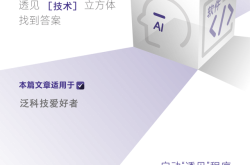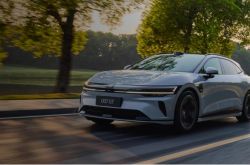China's Autonomous Vehicles Arrive in Europe! Daimler's Hometown Embraces "Chinese Radishes"
![]() 08/08 2025
08/08 2025
![]() 513
513
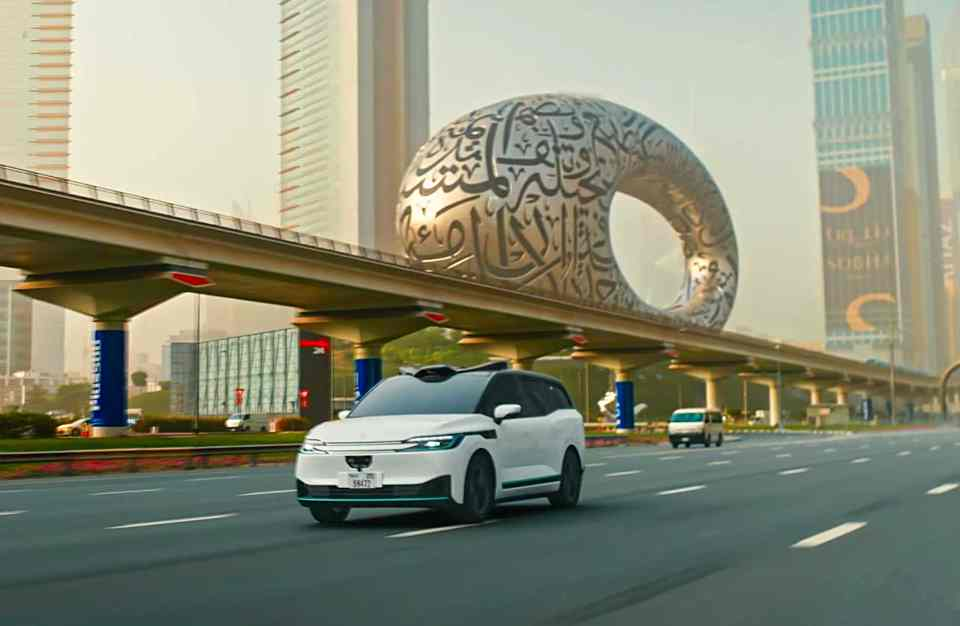
Why Are "Chinese Radishes" So Popular?
Manual Labor/Uncle Digger
Manually Edited/Uncle Jue
Produced by/Unicorn Observer
In 1885, when German inventor Karl Benz created the first gasoline-powered car, he could hardly have envisioned that over a century later, autonomous driving solutions from China would reshape Europe's transportation landscape.
On August 4, Luobo Kuaipao officially announced its strategic collaboration with Lyft, a leading global mobility platform, aiming to initially deploy thousands of autonomous vehicles in Germany and the UK by 2026, gradually expanding to cover the entire European market and establishing the largest autonomous driving fleet in Europe.
This announcement comes just half a month after Luobo Kuaipao's largest-ever driverless partnership with Uber—the "rigorous selection" by these two global mobility giants has positioned Baidu's "Chinese solution" as a pivotal variable in the race for autonomous driving supremacy.
As the birthplace of modern automobiles, Europe once defined the golden age of the automotive industry with brands like Daimler and BMW. However, in the wave of autonomous technology, due to factors such as lagging legislation and hesitant strategic choices, Europe has fallen behind in the competition with China and the United States.
The arrival of Luobo Kuaipao marks a restructuring of the global autonomous driving industry: Chinese technology is transitioning from a "follower" to a "leader," emerging as a "game-changer" by providing safe, efficient, and scalable autonomous driving solutions for Europe and the world.
01 Accelerated Overseas Expansion
As early as the beginning of 2023, industry reports indicated that Kuaishou was formally entering the credit field. By the end of 2023, Kuaishou further pursued its financial ambitions by recruiting talent across various positions, including risk control compliance and supply chain finance. The collaboration between Luobo Kuaipao and Lyft is regarded as a milestone event for Chinese autonomous driving technology to "land" in Europe.
According to the agreement, the two parties will use Germany and the UK as their starting points, deploying Luobo Kuaipao's sixth-generation autonomous vehicles in 2026, gradually expanding to thousands of vehicles to cover Europe's core urban areas. This is by far the largest-scale autonomous deployment plan in the European market and the first time autonomous technology has been implemented on a large scale in the birthplace of automobiles.
This collaboration is not surprising.
More than half a month ago, Luobo Kuaipao signed a contract with Uber, the world's largest mobility platform, planning to deploy thousands of autonomous vehicles in Asia, the Middle East, Europe, and the United States, gradually constructing a global autonomous mobility network.
The "double endorsement" from these two mobility giants serves as the best testament to the "explosive" momentum of Luobo Kuaipao's globalization strategy.
Looking back at Luobo Kuaipao's overseas expansion trajectory, its global layout hit the "accelerator" button as early as last year.
In November 2024, Luobo Kuaipao obtained Hong Kong's first batch of autonomous driving pilot licenses, achieving test breakthroughs from the airport surroundings to the Tung Chung living circle in just half a year. It safely drove over 15,000 kilometers in the complex environment of right-hand drive and left-side travel, with a 100% pass rate at complex intersections, demonstrating robust technical adaptability.
In March 2025, Luobo Kuaipao made consecutive moves in the Middle East: signing an agreement with Dubai to deploy 1,000 autonomous vehicles by 2028, aligning with Dubai's national strategy of "25% traffic automation"; and collaborating with Abu Dhabi to build the largest autonomous fleet in the region, with testing in the city's core area commencing in May.
Furthermore, it is reported that Baidu has established an entity company in Switzerland, using it as a "bridgehead" to enter Europe while exploring emerging markets such as Turkey.
From Wuhan Yangtze River Bridge to Dubai's Burj Khalifa, from the streets of Hong Kong to the banks of the Thames in London, every step of Luobo Kuaipao proves that China's autonomous driving technology can not only serve the local market but also adapt to complex global scenarios, providing the world with reliable mobility solutions.
This "multi-point flowering" layout is not merely geographic expansion but also forms an autonomous driving version of the "Silk Road" spanning Asia, the Middle East, and Europe—coping with high-density mixed traffic in Wuhan, adapting to high-temperature and sandy environments in Dubai, overcoming right-hand drive and left-side travel rules in Hong Kong, and preparing for icy roads and narrow streets in Europe's historical districts.
This global landing capability positions Luobo Kuaipao as another representative of China's technology exporting soft power.
As Baidu founder Robin Li stated, "Collaborating with Lyft to deploy autonomous mobility services in Europe, with the first landings in Germany and the UK, marks an important milestone for Luobo Kuaipao's globalization strategy. We will work with global partners to bring autonomous mobility services to users worldwide."
02 A Mutually Beneficial Journey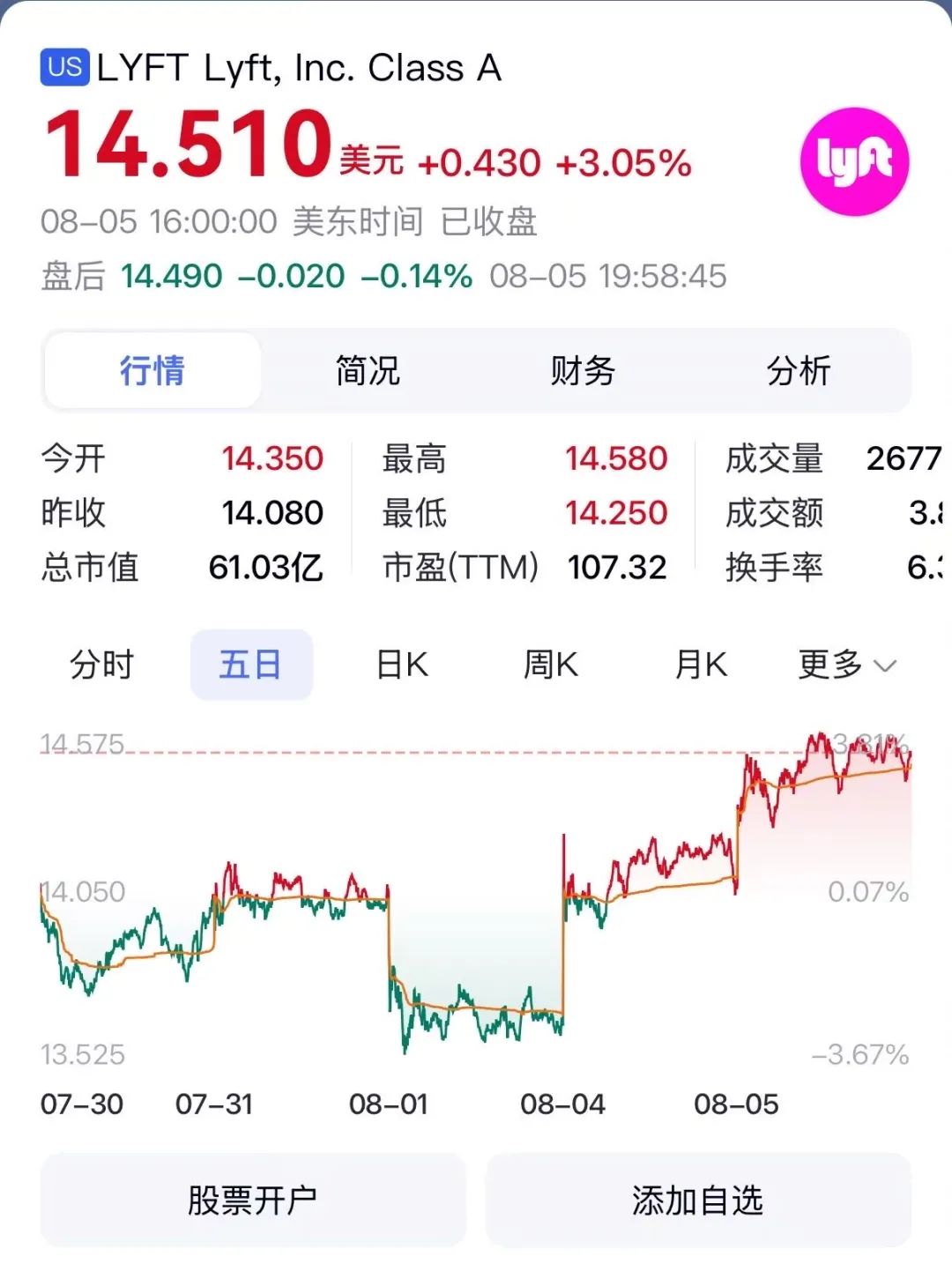
Following the announcement of the Luobo Kuaipao and Lyft partnership, Lyft's share price surged by more than 3% for two consecutive days. On August 5, Lyft's closing price on the U.S. stock market was $14.51, with a market value increase of over 2 billion yuan.
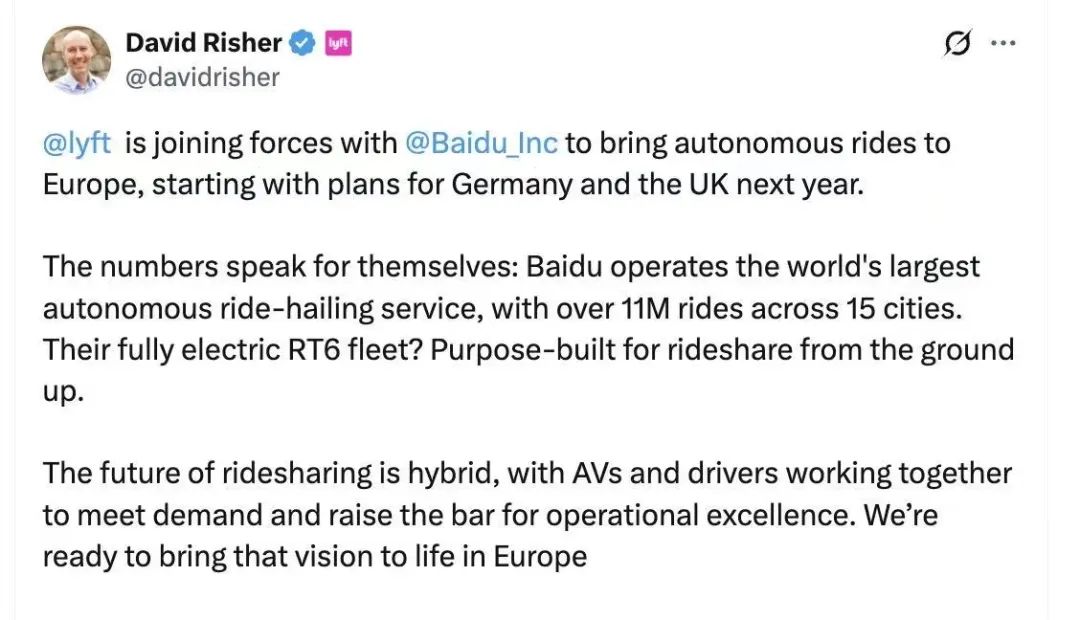
Lyft CEO David Risher was even more enthusiastic, tweeting praise for Luobo Kuaipao, emphasizing its leading role in the global industry.
For Luobo Kuaipao, partners like Lyft are highly valued. Lyft boasts a substantial user base in the global mobility market, particularly in the European market. By collaborating with Lyft, Luobo Kuaipao can swiftly enter the European market through its platform, realizing large-scale deployment of autonomous services, which will accelerate Luobo Kuaipao's global layout.
Citi analysts believe that Baidu's strategic collaboration with these two mobility giants will aid Apollo Go in exploring new markets with commercial potential, showcasing Baidu's strength in the autonomous driving value chain.
From Lyft and Uber's perspectives, isn't Luobo Kuaipao their optimal solution?
From a commercial standpoint, the collaboration between Luobo Kuaipao and mobility giants is a strategic synergy based on complementary technologies, markets, and ecosystems, a mutually beneficial journey of win-win cooperation.
Lyft CEO David Risher bluntly stated that the core reasons for choosing Luobo Kuaipao are its safety, reliability, privacy, and experience in landing services.
Through this evaluation, the underlying logic of Luobo Kuaipao earning trust gradually becomes clear—the triple advantages of technological maturity, safety redundancy design, and large-scale deployment capability.
Safety has always been the core issue in autonomous driving technology. Luobo Kuaipao has chosen a reliable technological route, adopting a technical architecture of "lidar + multi-sensor fusion + Apollo ADFM large model," constructing a perception and decision-making system far surpassing industry standards. The 5-layer 360° "perception network" has a significantly higher accuracy rate than pure vision solutions in detecting pedestrians at night and in extreme weather conditions such as rain, snow, and fog.
This technological advantage stems from long-term accumulation.
As a pioneer, Baidu has been deeply involved in autonomous driving for 12 years, delivering an impressive answer: ranking first globally in the number of high-level autonomous driving patent families, with over 170 million kilometers of L4-level safety test miles, and an accident rate only 1/14th that of human driving.
As one of the fields with the highest integration of artificial intelligence technology, autonomous driving technology can best reflect a company's AI capabilities.
In May 2024, Baidu released the Apollo ADFM large model, becoming the world's first large model to support L4-level autonomous driving. Through the integration of the full-link neural network of "perception-decision-planning," it achieves city-wide complex scenario coverage. By reconstructing autonomous driving based on large model technology, Apollo ADFM is over 10 times safer than human drivers, achieving deep technical verification and experience accumulation in the large-scale application in Chinese cities with tens of millions of people.
Large-scale deployment capability is another key bargaining chip for Luobo Kuaipao to gain favor from giants.
Compared to other players, Luobo Kuaipao's "autonomous + large model" architecture boasts strong scene generalization ability—it only takes half a year to complete the preparation for full-area autonomous driving services in a new city, much lower than the industry average of 1-2 years.
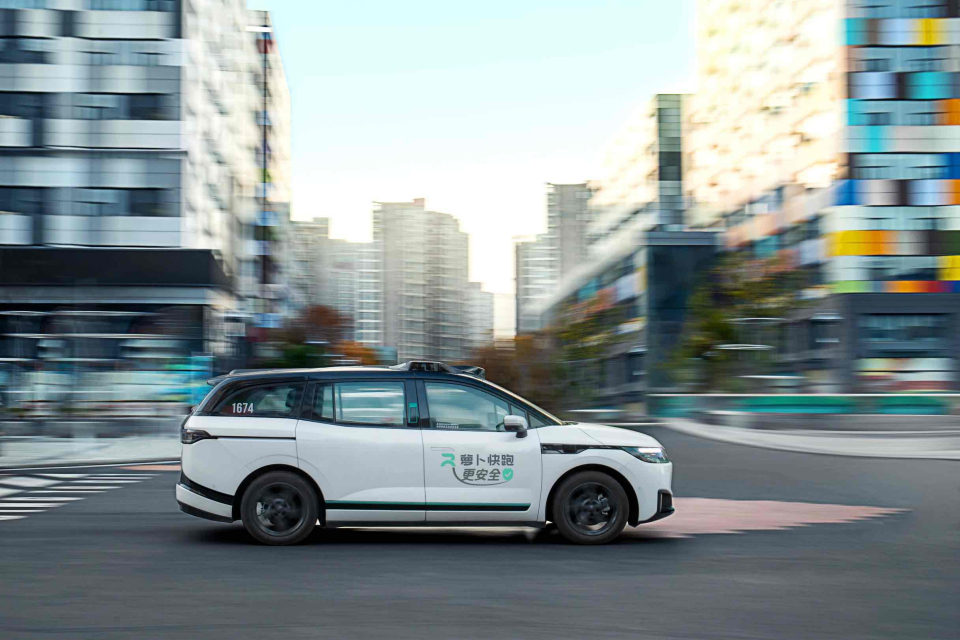
In December 2024, Luobo Kuaipao obtained Hong Kong's first batch of autonomous driving vehicle pilot licenses and launched road tests in North Lantau. As a right-hand drive and left-side travel area, Hong Kong's traffic rules are markedly different from those in the mainland. However, Luobo Kuaipao swiftly completed driving strategy adjustments through the large model's generalization ability, currently having safely driven over 14,000 kilometers, performing stably in diverse road scenarios, and achieving a high level of automated driving.
Through hardware iteration and large-scale mass production, the cost of Luobo Kuaipao's sixth-generation autonomous vehicles is reduced by 60% compared to the previous generation, costing approximately 200,000 yuan, only 1/7th that of Waymo's autonomous vehicles, and reaching the commercial cost threshold two years earlier than Tesla's Cybercab.
This cost advantage is highly compatible with Uber and Lyft's "asset-light strategy"—after collaboration, mobility platforms can swiftly access mature autonomous services without incurring huge R&D and vehicle procurement costs, forming a synergistic effect of "technology + traffic."
Of course, the more profound value lies in ecological synergy.
Luobo Kuaipao is not merely a technology provider but also a co-builder of the global mobility ecosystem. At the 2025 World New Energy Vehicle Congress (WNEVC), the head of Baidu's Intelligent Driving Business Group for Europe and the Middle East revealed that Luobo Kuaipao will collaborate with local partners in the UAE to build a comprehensive ecosystem and may explore innovative models such as battery swapping services in cooperation with new energy companies in the future.
This ability to "do as the Romans do" distinguishes it from closed technology exporters, making it a more acceptable partner.
With more mature technology, more economical costs, and the ability to provide tailored services that "adapt to local conditions," who can resist such Chinese radishes?
03 On the Cusp of an Explosion?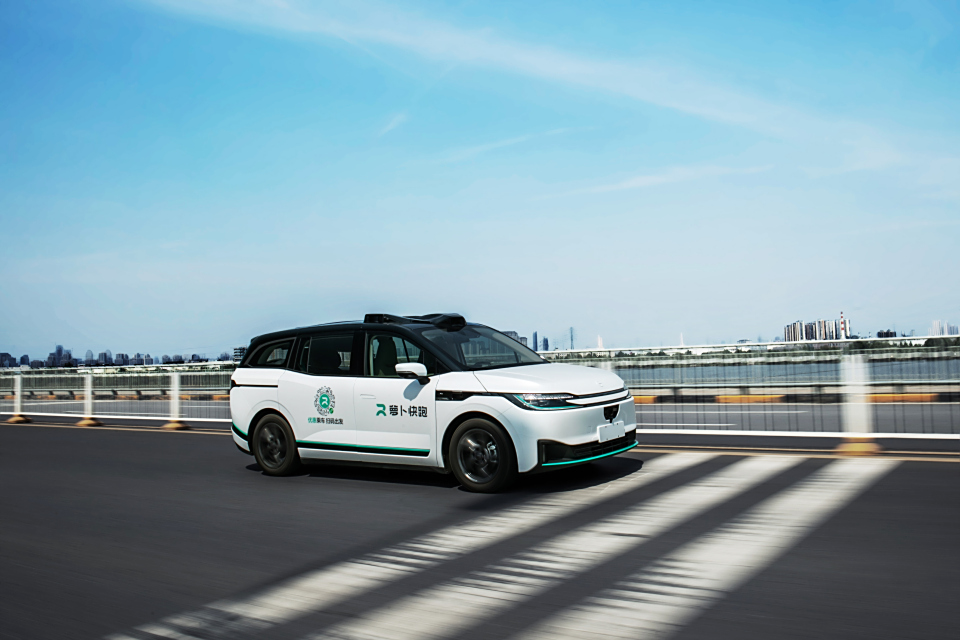
On a morning in 2026, Hans, a Berlin citizen, taps a few times on the Lyft App, and a white-and-green autonomous vehicle filled with a sense of technology silently drives up. There is no driver inside, the seats are automatically heated and massaged, and the large screen displays real-time traffic analysis—this sixth-generation autonomous vehicle from China's Luobo Kuaipao takes him through the Brandenburg Gate to his workplace.
Will such a scene become routine for human travel? Or is the "iPhone moment" of autonomous driving technology arriving?
A Goldman Sachs report offers an optimistic outlook: the global Robotaxi market is expected to experience explosive growth, reaching a scale of $40 billion to $45.7 billion by 2030, with a compound annual growth rate exceeding 60%. Musk asserts that Robotaxis will make Tesla a company with a market value of $30 trillion.
Currently, the autonomous driving industry indeed bears many similarities to the critical point before the iPhone's launch in 2007.
In terms of hardware, the cost of lidar has dropped by 90% in a decade, and the computing power of high-performance chips has exceeded 2,000 TOPS, providing a foundation for technology deployment; in terms of software, large models drive autonomous driving from "rule-based" to "data-driven," with systems such as Apollo ADFM capable of handling over 95% of daily scenarios; in terms of policy, major countries worldwide are accelerating legislation—California in the United States allows the commercialization of fully autonomous vehicles, the UK's "Automated and Electric Vehicles Act" sets a 2026 implementation timeline, and we have also launched pilot policies in 51 cities, gradually dissolving regulatory barriers.
Against this backdrop, a three-way competitive landscape has emerged in global autonomous driving technology: Waymo in the United States is deeply rooted in the local market, Tesla is rapidly expanding with a pure vision route, and China's Luobo Kuaipao is accelerating its globalization with the dual advantages of "technology + ecosystem."
The competition among the three is not merely about corporate rivalry but also about the battle for technical standards and industrial discourse power.
We are delighted to witness the accelerated deployment of Luobo Kuaipao, but we cannot afford to be complacent.
On the one hand, it proves that China has transitioned from a "follower" to a "runner" or even a "leader" in the field of autonomous driving, possessing the ability to export technical standards.
On the other hand, global competition is still intensifying: Waymo has covered 1,200 square kilometers of urban areas in the United States, Tesla plans to mass-produce millions of Robotaxis by 2026, and Europe is seeking differentiated breakthroughs through "vehicle-road collaboration."
To maintain an edge in this competition, government-enterprise collaboration is crucial.
At the governmental level, it is imperative to expedite the establishment of a legal framework that adheres to international standards, foster the expansion of integrated vehicle-road-cloud infrastructure to a broader range of cities, and furnish enterprises with testing environments and data support. At the enterprise level, it is crucial to persistently fortify technological barriers, particularly by overcoming "bottleneck" issues in core domains such as LiDAR and automotive-grade chips. At the industrial chain level, a collaborative ecosystem comprising "automakers, technology companies, and suppliers" must be cultivated to minimize marginal costs and elevate global competitiveness.
In this AI-driven mobility revolution, China is not merely a participant; it is also emerging as a rulemaker and trendsetter.
While the precise timing of the "iPhone moment" for driverless technology remains uncertain, one thing is clear: the Chinese solution has already secured a prominent position on the global stage, and it is poised to forge its own path, diverging from the traditional trajectory of European driverless technology. (End)


